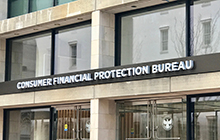The Consumer Financial Protection Bureau (CFPB) recently issued a new procedural rule to streamline how it determines which nondepository institutions it has the authority to supervise. According to the CFPB, the new rule coincides with a change in organizational structure. But it also indicates an affirmative broadening of its regulatory reach.
Background
The CFPB has supervisory authority over banks, thrifts, and credit unions with assets over $10 billion, as well as their affiliates. (The current list is here.) Beyond that, the Consumer Financial Protection Act (specifically section 1024(a)(1)(C)) also authorizes the CFPB to designate other nondepository institutions for supervision. Specifically, the CFPB can designate for supervision any “covered person” (an offeror or provider of a consumer financial product or service, or its service-providing affiliate) who – “after notice to the covered person and a reasonable opportunity for such covered person to respond” – the CFPB “has reasonable cause to determine” has engaged in “conduct that poses risks to consumers.” 12 CFR § 1024(a)(1)(C). In accordance with that authority, the CFPB can designate certain nonbanks for supervision. However, according to the CFPB, although it issued procedures in 2013 to govern such designations, the authority to do so was largely unused for years. Indeed, according to the CFPB, until a November 2023 decision in a contested proceeding, it had not designated a nonbank for supervision without the entity’s consent. In November 2022, however, the CFPB announced it would begin to make active use of its supervisory designation authority, and made limited amendments to some of its related procedures.
Changes to Procedures
The ordinary process by which the CFPB designates a nonbank for supervision is for an initiating official to commence a contested proceeding by serving the respondent with a “Notice of Reasonable Cause” (the Notice). The new rule changes the 2013 procedures, in the following ways:
- Elimination of Associate Director Role. In late February 2024, the CFPB began a transition to a new organizational structure, splitting its supervision and enforcement work and eliminating the position of Associate Director of Supervision, Enforcement, and Fair Lending. Under the 2013 rule, the Associate Director submitted a recommended determination to the Director, and then the Director issued a final determination. The elimination of this role may streamline the referral process.
- Methods for Serving the Notice. Service methods in the 2013 rule were patterned on the service of a “notice of charges” under the Rules of Practice for Adjudication Proceedings. The new rule permits other methods that are “reasonably calculated to give notice.”
- Separation of CFPB roles. The rule states that CFPB employees who advise the initiating official cannot also advise the Director in his adjudicative role. The 2013 rule included a similar separation of functions at the Director level, but at the Associate Director level it did not mandate a similar separation. According to the CFPB, while this separation is not required by the Administrative Procedure Act, the CFPB maintains it as a matter of policy.
- Additional Briefing. The rule codifies that the Director may request additional briefing from the respondent nonbank, the initiating official, or both, and allows the initiating official to reply to the nonbank’s response to the Notice. The 2013 rule did not allow for the initiating official to respond to the written reply.
- Consent to Supervision. The rule consolidates two previous provisions regarding how a nonbank may voluntarily consent to the CFPB’s supervisory authority. Under one provision of the 2013 rule, a respondent could respond to a Notice by signing an enclosed consent agreement that led to a two-year supervision. Under a separate provision, the respondent could enter into a consent agreement, with a duration to be negotiated, case-by-case. Under the new rule, a proposed consent agreement will continue to be enclosed with the Notice and an agreement can also be reached at any other time, but the rule will no longer mandate a two-year period.
- Issue Exhaustion. The new rule (section 1091.408) contains an issue exhaustion provision. As the CFPB notes, “Administrative review schemes commonly require parties to give the agency an opportunity to address an issue before seeking judicial review of that question.” Carr v. Saul, 141 S. Ct. 1352, 1358 (2021). The new rule is explicit that “[a] respondent must raise an argument” in, where applicable, its written responses, its petition for termination, and its supplemental briefing, “or else it is not preserved for judicial review.” Further, the rule state that “[a]n argument must be raised in a manner . . . that provides a fair opportunity to consider the argument.”
Public comments must be submitted 30 days after publication in the Federal Register. The CFPB is inviting comments, but because the new procedure is considered a rule of organization, procedure, or practice, it is exempt from the notice-and-comment requirements of the Administrative Procedures Act.
Conclusion
Although the CFPB “anticipates it will continue to conduct a limited number of proceedings relative to the size of the market of covered entities subject to this rule” (which the CFPB estimates to amount to “approximately 154,430 entities”) the promulgation of the new rule is an indication of a broadening regulatory reach by the CFPB into nonbank providers of consumer financial products and services.

